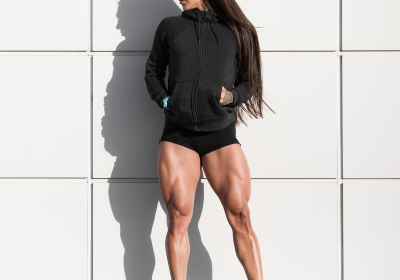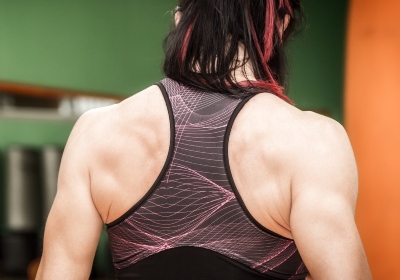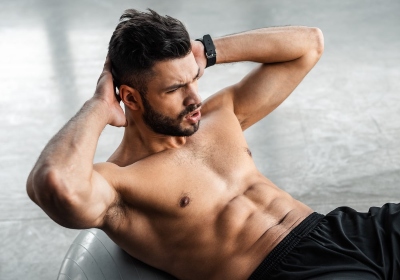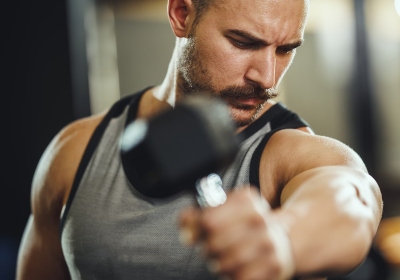VIDEO
Knee Raise
- Abs
- Trapezius
- Upper Back
- Shoulders
- Gluteus
- Quads
Level:Intermediate
Trainer:Nick Taylor
Equipment:Monkey Bars
Knee Raise
- Abs
- Trapezius
- Upper Back
- Shoulders
- Gluteus
- Quads
Level:Intermediate
Trainer:Nick Taylor
Equipment:Monkey Bars
Grab the bar shoulder-width apart with an overhand grip. Lift up your legs bending the knees. Try not to swing, keep your back and core straight as possible. Repeat for the desired amount of repetitions.
save to ...
RECOMMENDED FOR YOU
ARTICLES
To work out the perfect buttocks, you need to know what functions they have. In this article, you may read everything about the structure and functions of the gluteus muscles. So, let’s start examining the glutes right now!
First things first, you need to know that glutes consist of three separate parts: large, medium, and small. Accordingly, the functions of the glutes reflect a combination of the functions of these three muscles, and if any of the muscles are not used, then we lack some of them, and, as a result, we do not get the desired look of the buttocks. Probably, it is time to have a closer look at every glute muscle.
The gluteus maximus is the largest of this group of muscles and can reach the thickness of 2-3 cm. It has a rhomboidal shape and almost completely o covers the middle and small gluteus maximus, being on top. In fact, it is this muscle that we usually associate with the considered area of the body that creates the main visible volume.
Here are the main functions of the gluteus maximus:
maintains the position of the torso when the person is standing
assists in extension of the torso after bending over
rotates the hip outward
acts in hip extension.
This muscle is very active during stair climbing and different types of stepping on an elevated surface. It is involved as soon as you change from stepping to running. It is active during upward jumps and various pushing movements of the legs. Besides, the gluteus maximus works together with other muscles in squats and all exercises involving the extension of the thigh and torso.
The middle gluteal muscle (lat. musculus gluteus medius) has a triangle-like shape. It is located under the gluteus maximus but is visible from behind and the side.
The main functions of the middle gluteus muscle are:
extends the hip to the side
participates in the inward and outward rotation of the hip
participates in the torso straightening
And the last, but no less important is the gluteus minimus. This muscle is not visible from the outside because it is the deepest of all three muscles and is completely overlapped by the gluteus medius and gluteus maximus. The shape of the small gluteus maximus resembles the middle gluteus maximus, but it is thinner.
In fact, the functions of this muscle are almost similar to that of the gluteus medius, and they usually work in tandem to create a beautiful shape of your buttocks.
If you are working out your entire body in one workout, do it at least three times a week. Choose one exercise for your gluteus and incorporate it into your program. To avoid stagnation, change exercises after 1-2 workouts.
If you prefer splits, choose 1-2 movements and do it on your leg workout day. Keep in mind that most glute exercises also load the muscles of the posterior surface of the thigh. So if you want to do a heavy deadlift or leg press in a machine, it is better to start with them. Otherwise, the muscles will get tired and you will not be able to work out fully.
We hope that you know more about your glutes right now and your workout will be more effective! Have a nice shape, dear friend.
Read more
One of the most important running muscles is the quadriceps - the large muscle at the front of the thigh. It has been scientifically proven that regular strength training improves workout performance and reduces the risk of injury, as well as strengthens your back, and leg muscles, making your running more productive.
The quads, also known as the quadriceps muscle, is a group of muscles located at the front of the leg above the knee. It is one of the largest and strongest muscles in your body that consists of four heads: fastus medialis (medial wide), vastus intermedius (intermediate wide), vastus lateralis (lateral), and rectus femoris (straight thigh muscle). Almost every action performed by the legs involves two or more heads of the quadriceps. The quadriceps muscle plays an important role at the beginning of the movement (quick start) and during ascent and descent in elevated positions - which is why you may experience painful sensations in this area of the leg after an intense uphill workout.
According to researchers at the University of Delaware, strong quadriceps act as cushioning and can protect the knees and the entire musculature of the hip from common running injuries. Often many runners are injured because they have weak and underdeveloped quadriceps, so it is especially important to strengthen them.
By training and strengthening the quads, you can get the following benefits when running:
Increased speed. Strong quadriceps help you tackle steep hills and climbs more easily and make pushing off the ground more powerful, resulting in increased speed.
Reduced injuries. According to research, poorly developed quadriceps are often associated with many running injuries. For example, a common injury such as the 'runner`s knee' results from weakness in these muscles, which are unable to stabilize the knee joint during the movement.
Increased endurance. Strengthening the quadriceps muscle will make your running more effortless and efficient, which contributes to increased running volume and endurance.
Training
The quadriceps occupy 70% of the muscle mass of the leg, so it is their development that is fundamental in leg training. The main exercise for developing the quadriceps is the squat. But, for beginners, at the first stages of training, it is better to start with leg curls sitting in an exercise machine, leg press, and hyperextensions to strengthen the lower back, to avoid injuries, in order to prepare the base for the heavy squats. It is a good idea to include squats in your training plan after about six months of training.
Read more
The trapezius muscle is a crucial straight broad muscle that is located in a superficial position, in the back part of the neck and the upper back. The trapezius muscle has the shape of a triangle, the base facing the spinal column, and the top - to the acromion of the scapula. These kinds of muscles on both sides of the back together are trapezoidal.
There are three parts of it:
Upper part: Once the spine is fixed and raises the scapula. With a fixed shoulder blade, it straightens the head and neck.
Middle part: When the spine is fixed and the head brings the scapula to the spine. With the contraction of all parts of the muscles, the adduction of the shoulder blades also occurs.
Low part: It downs the shoulder girdle when the spine and head are fixed.
The upper trapezius muscles are trained by raising and lowering the shoulders with weights in the hands (performing shrugs). The lower part is trained by bringing the shoulder blades of the back under load.
Training.
Band Seated Row. Sitting on the floor with your legs extended loop an elastic band around your soles and hold one end in your right hand. Squeezing your shoulder blades and making a twist to the right with your torso, pull the band toward your waist. Then repeat the action to the other side.
Planche. It is an advanced gymnastic exercise. You should have a high level of fitness preparation and strong hands. It is the skill in which your body should be parallel to the ground supported by hands and arms with your legs raised.
S-Leg Pushup. Put your hands and toes on the mat. Keep your arms straight, but don't lock your elbows. Align your feet making the straight line with your arms and core. Inhaling, bend your elbows and lower your chest to the mat slowly. Straighten your arms to lift your core up, exhaling, at the same time lifting one leg off the ground.
P-up Variation. Put your hands and toes on the mat. Keep your arms straight, but don't lock your elbows. Align your feet making the straight line with your arms and core. Inhaling, bend your elbows and lower your chest to the bench slowly. Straighten your arms to lift your core up, exhaling.
Read more
Since ancient times, developed muscles have been one of the hallmarks of a harmoniously developed, athletic body. There is no such thing as 'abs' in anatomy. This is a conditional abdominal muscle. There are four of them:
rectus;
internal oblique;
external oblique and transversus.
The rectus abdominis muscle is the largest in area. It’s a popular fallacy that there is a 'lower' and 'upper' press, but the rectus muscle does not have such a division. The notorious 'six-pack' stands out because of the tendon bridges on the rectus abdominis muscle. The muscle bundles of the external abdominal muscle begin from the lower eight ribs and extend radially downward. The transverse muscle is located deeper than the other abdominal muscles. In this case, the tendon extension in the upper two-thirds passes behind the rectus muscle, and in the lower third - in front. Partly because of this, the lower abs are less workable than the upper ones. The abdominal muscles are referred to as the core muscles, the muscle complex responsible for stabilizing the spine, pelvis, and hips. Each of the abdominal muscles is responsible for its own functions. One of the most common fallacies in abdominal training is that the more reps we do in a set, the stronger and bigger the abs will be. In fact, the muscles of the abs are no different in terms of training from the biceps. To increase the biceps, you will do one hundred reps per set. However, you will reduce the number of sets and reps, but increase the load. By increasing the number of repetitions in the set, you will develop strength endurance, but the muscle will not get thicker from this. It is much more effective to increase the load, do sets with weights and reduce the number of repetitions in the set. Three factors affect the appearance of your abs: posture, body fat percentage, and muscle development.
Posture.If a person pumps muscles but slouches, and he has excess fat, then the abs will not be visible. If a person does not pump the abs, but he has a good posture and a small percentage of body fat, then his belly will look flatter. That is why it makes no sense to start with the question of how to properly pump the abs. You need to start by working on your posture. The good news is that your core muscles are also responsible for correct posture. And they are usually used in workouts with an emphasis on the abs.
Fat percentage.Measuring body composition on an analyzer scale will show the percentage of body fat, which explains why the abs are invisible. If the fat is more than 15-20%, then it’s hard to see your six-pack. At 15% or less, the abs begin to be seen. 8% is abs athletes have. But do not try to completely get rid of fat for beautiful abs. Fat is necessary for the proper functioning of the endocrine system and other processes in the body. To achieve tangible results, it is important to monitor the factors that affect the percentage of body fat like food, sleep, stress levels, and the amount of daily physical activity.
Muscle development.You mustn’t focus only on abs exercises, you need to develop the body complexly and do a variety of activities. Strength training will strengthen your muscles, burn calories and build endurance with interval training. Recovery activities help with posture, flexibility, and muscle balance. The optimal training program can be selected after fitness testing, which takes into account how a person moves, what restrictions he has.
Read more
The shoulder muscles are divided into two groups. The anterior group consists of flexors: the coracohumeral, the brachialis, and the biceps brachii. The posterior group includes the extensors: the triceps brachii and ulnar.
The coracohumerals start from the coracoid process of the scapula fuses with the short head of the biceps brachii and pectoralis minor and attaches to the humerus at the level of the upper edge of the brachial.
The brachials start from the lower half of the anterior surface of the humerus and the intermuscular septa of the shoulder and attach to the tuberosity of the ulna and its coronal process.
The biceps brachii has two heads starting on the scapula from the supra-articular tubercle (long head) and the coracoid process (short head). It attaches to the forearm to the tuberosity of the radius and the fascia of the forearm. It belongs to the bicarticular part. Concerning the shoulder joint, the biceps of the shoulder is the flexor of the shoulder, and the elbow is the flexor and instep support of the forearm.
The triceps brachii is located on the back of the shoulder, has three heads, and is a bicarticular. It participates in the movements of both the shoulder and the forearm, causing extension and adduction in the shoulder joint and extension in the elbow.
The ulnar starts from the lateral epicondyle of the humerus and radial collateral ligament and the fascia; it is attached to the upper part of the posterior surface and partly to the olecranon of the ulna in its upper quarter. The function of this is to extend the forearm.
The bundles of the deltoid muscle perform different functions, so it will not work to load them all with one exercise: you will have to include at least three movements in the training. All exercises are divided into three parts: for pumping the front, middle and back beams. Pick exercises from our list below and add them to your workouts. The weight is necessary so that the last repetitions in the approach are given not easily, but without compromising the technique. You can train your shoulder straps both at home and in the gym. But it is necessary to have a bar and a gantry. Weight must be chosen in such a way that in every set it was possible to raise the average 8-10 times. This is how you can increase the volume and mass. If the same goal is set - to increase the strength, to train in the face of more severe conditions. In this case, the number of repeats will be 5-8. The number of reps is 4-5.
Barbell bench press. Take the shell on your chest, bring your elbows forward, tighten your abs, buttocks, legs. Squeeze the bar up, lower it back and repeat. When the bar passes your face, do not lift your chin, but squeeze it in yourself: this way the bar will go along the optimal trajectory. If the projectile remains in front of the body at the top point, and not above it, the load on the lower back increases. Therefore, try to take the barbell behind your head.
Standing dumbbell press. Raise your arms with the selected weight to shoulder level, turn your palms forward with your fingers. Squeeze the dumbbells up and take them slightly behind your head, and then lower them to the starting position and repeat. Do three to five approaches 10-12 times.
Seated Bent-Over Dumbbell Routing. Sit on a bench, tilt your body with a straight back, as far as flexibility allows, hold the dumbbells in your lowered hands. Without changing the position of the body, spread your arms with the taken weight on the sides to shoulder level. Slowly lower the dumbbells to the starting position and repeat.
Read more
SAVE TO ...





